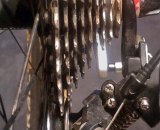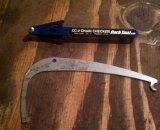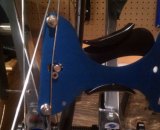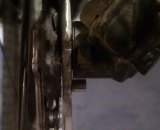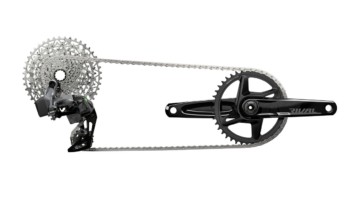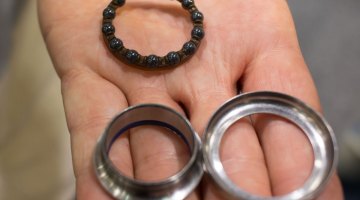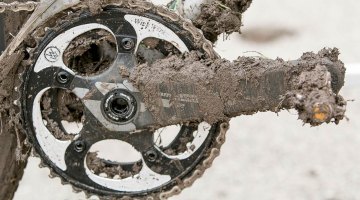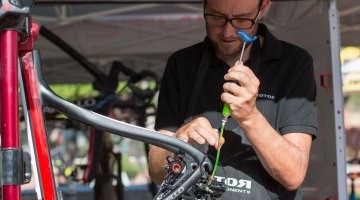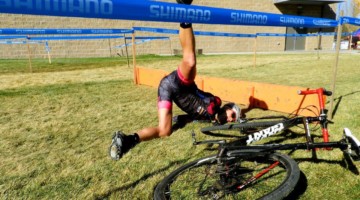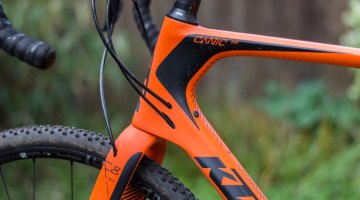by Jason Gardner
DNF: these are probably the last symbols we want to see next to our name on the race results list. In endurance events, the DNF (Did Not Finish) is usually linked to some physical failure, an inability to achieve the expectations of the day. That is rarely the case in cyclocross. In cyclocross, the DNF usually means something catastrophic happened. We’ve all seen Mr. DNF before, pushing his bike back to the parking lot, various parts dangling like Christmas tree ornaments strung by two year old. Or sometimes, the alleged bike is so badly mangled its rider is compelled to hoist it onto their back like some trophy of shame. Mr. DNF says little, at least little that is intelligible or acceptable to prime time television. The walk back to the car is long and frustrating, full of the questions of what might have been. The salt of Monday’s repair bill isn’t going to help.
The sad reality is that most catastrophic failures in ’cross racing result from very simple factors. I have compiled a small list of race-ending mechanical problems that could have been avoided with a small dose of precaution and a dash of extra care. These are not all or even the most common mechanical issues in ’cross racing but these all have two things in common: first, they can absolutely end your race, giving you a regrettable DNF, and second, they can easily be prevented.
Chains
A broken chain is virtually impossible to recover from in a race. Even if you have a tool with you, and even if you are quite handy with said tool, the time required to repair a broken chain mid-race is mostly insurmountable. In many cases, a broken chain causes other problems such as a bent rear or front derailleur, a chain jammed into the crank set, or other wheel damage. While it is impossible to tell when a chain will break, there are a few precautions that can be taken.
First, keep track of your chain wear. Invest in a chain wear measurement device or make sure your mechanic is checking it when it’s in for service. Replace a worn chain. Second, inspect your chain for bent plates. This is easy to do when lubricating the chain. If a link is bent or pulling from the pin, replace your chain. Finally, do not ride a chain that has been broken and repaired. And what if it’s a new chain? Well, that depends on how it broke, why it broke, and if it was repaired to the proper length. A broken and repaired chain is a gamble and a gamble with a possible high price. When in doubt, replace it and give yourself greater security.
Spokes
Broken spokes are good at creating one thing: wheels that don’t roll. A broken spoke on a low spoke count wheel can make the problem much more severe. Furthermore, broken spokes have a nasty tendency of getting caught up in other parts of the bike and complicating an already messy situation. Like chains, it is nearly impossible to predict when a spoke will break, but there are some precautions that can be taken to circumvent unnecessary spoke breakage. The first involves wheel care which specifically considers spoke tension. A true wheel doesn’t necessarily indicate a strong wheel. Have your spoke tension measured and recorded. A high imbalance in spoke tension in which some spokes are much higher in tension than others indicates a wheel in prime condition for spoke breakage. Make every attempt to equalize the relative tension and keep track of it. A quick way to survey what’s going on: tap each spoke with a metal object and listen to the pitch, as spokes with the same tension should have the same pitch (as other spokes on the same side if a rear wheel).
The effort involved in an objective evaluation of your wheel’s condition is invaluable in projecting its usability. If a wheel has broken up to three or more spokes from spoke fatigue, replacement or rebuild is highly recommended. Replace damaged spokes, especially those that have received damage from the chain dropping off the large cog. When replacing spokes, always use the proper length and some manner of thread preparation. Given a little extra attention, your wheels don’t have to be the culprit.
Derailleurs
Without question, the most common culprit to catastrophic race-ending failure that I’ve seen is the bent derailleur hanger.
A bent derailleur hanger most often announces itself when the rider shifts in the lowest gear cog, the largest cog. When the hanger is bent the lower pulley sits more inboard to the wheel than it should. In the lowest gear, that orientation allows the inner plate of the derailleur to snag on the spokes of the rotating wheel. Result? The derailleur gets stuck in spokes, wraps up, breaks, tangles the chain around the cassette, and usually breaks a spoke or two, or at least severely sends the wheel out of true. When this happens, your day is over and Mr. DNF heads back to the car.
The prevention, again, is simple. Check your rear derailleur hanger when you service your bike and before the race. If the rear shifting is slow at the larger cogs of the cassette but fast at the smaller cogs, it is very likely the hanger is bent. If the derailleur audibly taps the spokes in the large cog, stay out of that gear. Replace a hanger that has been severely bent. A low gear limit screw that is too far out and allows the derailleur to shift past the large cog is also capable of producing this failure, so keep the limit screws in check. Attention to derailleur hangers and limit screw settings can save more than your day.
Last Minute Fixes
The late night pre-race overhaul can likely be blamed for countless DNF’s. We’ve all been there, at about 11pm the night before the race, scrapping to put our freshly cleaned parts back on in the dim incandescent light of the garage floor, perhaps a few beers deep and already an hour overdue. It’s the perfect cocktail for simple oversights. The most common I’ve seen has been the terrifying crank arm fall-y off-y. If a crank arm falls off mid race, it is because the person working on it forgot to secure it. First of all, avoid the late night overhaul. Second, double-check your bolts after the servicing, and third, give them a pre-race check. Yes, you’ve heard it a thousand times, but it is far too easy to let it ruin a race, a day, or an expensive part.
About Our Mechanic, Jason Gardner of Jinji Cycles:
Born and raised in Grand Junction, I started mountain biking at the age of 12 in the early 90’s. Unable to afford nice equipment or bike shop service, I was set on a path of working on my own stuff for many years. I got my first bike shop job out of college and spent the next few years working at different shops and working my way up to service manager. I quickly learned that service managers don’t work on bikes all that often and I devised a plan to open a bicycle service center that caters more to the elite cyclist. I received USA Cycling’s mechanic’s license and opened up Jinji Cycles in Denver in 2008. I love working to make bikes awesome and I hope my contributions here will help readers do the same.













